Restrictions to seismic acquisition increasingly limit the positioning of both sources and receivers at theoretically prescribed locations. Designing and subsequently repositioning station locations with respect to those restrictions has become an important and time-conscience aspect of both land and marine seismic programs. Historically, deviations from theoretical locations are prescribed in a set of station positioning guidelines, such as skid and offset guidelines or bingo-card methods (Cooper, 2004). These methods are surface-based approaches and relate to theoretical locations. They make assumptions that may not provide an optimal station location. A new sub-surface based method for optimizing station locations that utilizes sampling and imaging criteria is presented, with benefits of its use highlighted in a case study.
Introduction
Seismic acquisition parameters are typically established by a thorough review of existing seismic data, as well as the use of theory and/or modeling to determine the expected waveform. This analysis leads to a set of imaging requirements – trace density, distribution and statistical diversity – for a given program. A full wavefield design consists of sources and receivers positioned so as to generate midpoints with a full complement of offsets and azimuths. Figure 1 shows the theoretical layout, and resulting offset-azimuth distribution for a particular bin. The rays in the spider plot, and corresponding dots in the polar azimuth plot, correspond to the offset (distance from center) and bearing (towards the receiver) for all of the traces within the bin.
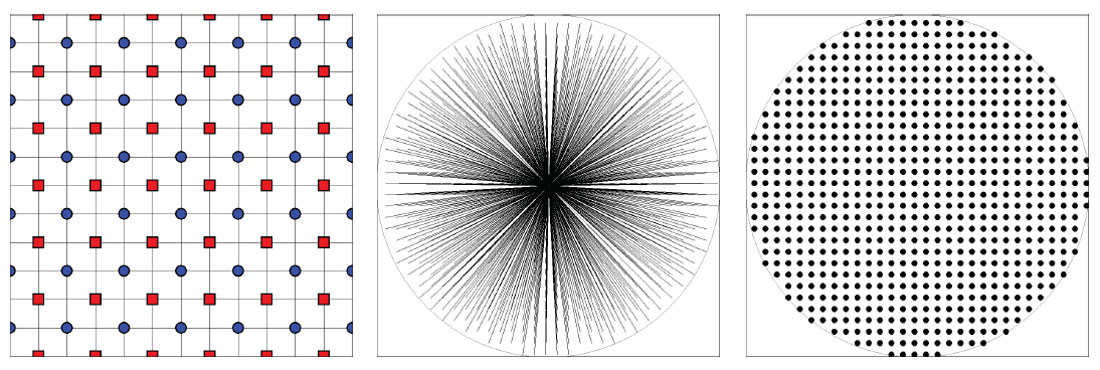
Most, if not all, theoretical designs do not sample the wavefield completely and instead approximate it by choosing a geometry of station and line intervals. The result of which is to remove azimuth and offset content relative to the full wavefield. Figure 2 shows the effect of decimating the full wavefield design into lines and stations, along with the resulting spider and polar azimuth plots. With fewer offsets and azimuths used to approximate the full wavefield, determining optimal station locations becomes entwined with the notion of a station’s “area of responsibility” (Cooper, 2004) and not directly by the sampling criteria from which the theoretical locations were originally determined. This approach, where station locations are assigned “source and receiver bins” leads to mitigating surface restrictions to seismic acquisition with the concept of skid and offset guidelines. As skid and offset guidelines assume all other stations remain at theoretical locations as well as a focused midpoint distribution within bins, the unilateral use of the method leads to sub-optimal trace distribution and offset-azimuth distribution within bins.

Skid and Offset Guideline Issues
In a CMP scatter, or bin fractionation design (Cordsen, 2000), the distance in which a station can move from its theoretical location while contributing to the same bin is dependent on the direction of the movement. With a double scatter design, which has four theoretical midpoints in each bin, in order to keep the midpoints in their original bins the stations can only move one half of a bin dimension in one direction, but three halves of the bin dimension in the opposite direction, shown in Figure 3. Skid and offset guidelines do not capture these complexities, and depending on the choice of bin grid orientation, the station movements will result in CMPs drifting out of the intended bin and fold imprints will be in the final dataset.

The skid and offset guideline method also assumes that receivers are unaffected by source restrictions and remain at theoretical locations, and vice-versa with sources. As long as this assumption holds true, the method will continue to contribute traces to the appropriate bin, though irrespective of the desired offset and azimuth contribution. If the receivers do not remain at theoretical locations, skid and offset guideline repositioned sources do not contribute midpoints to the appropriate bins and fold striping results (Millis and Crook, 2013). Figure 4 is an example where a source restriction, identified with red lines, prevents sources from being placed at their theoretical location. The restriction can be thought of as a pipeline right-of-way in an area with significant vegetation. Due to stakeholder requests, a receiver line occupies the pipeline right-of-way. With receivers no longer at their theoretical location, skid and offset guidelines recommend source locations where they contribute to fold striping.
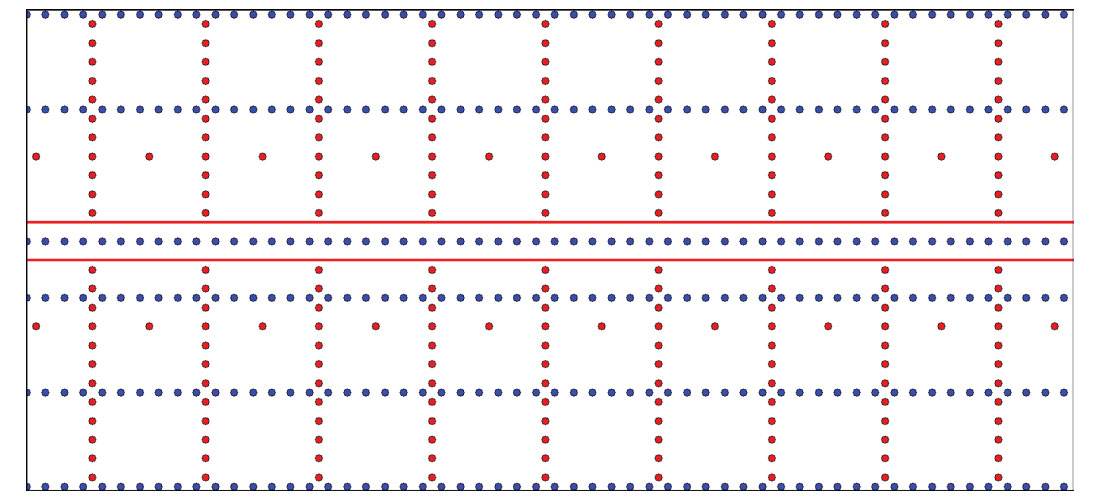
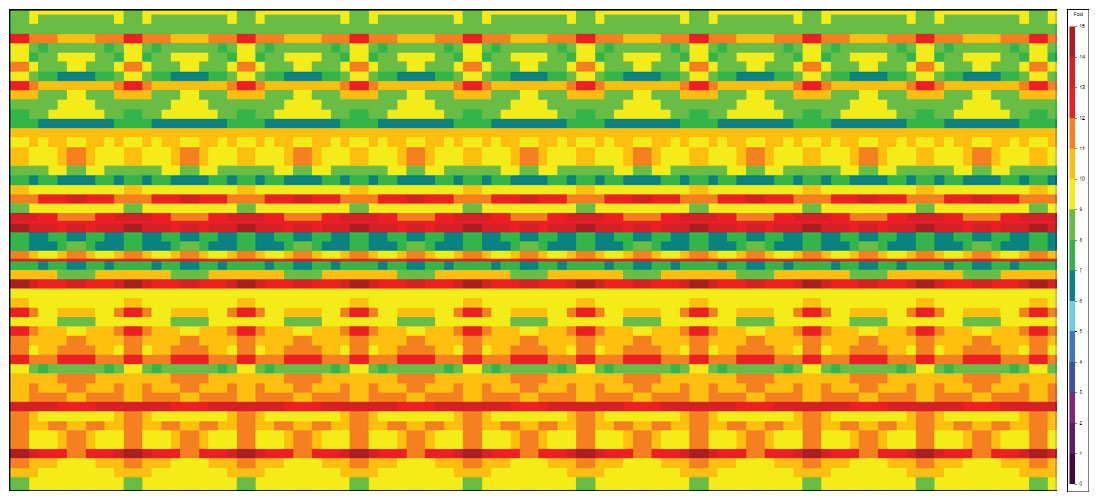
ORM Method
Consider a distribution of midpoints that has been chosen as a manner of adequately sampling the seismic waveform. By convention they are binned according to established imaging criteria, which yields a comprehensive set of bin attributes, such as trace locations within the bin, trace density, offset and azimuth. The populated bin grid completely describes the layout geometry of sources and receivers.
By limiting where stations can be positioned, surface restrictions, by proxy, limit the trace density, trace location and associated offset and azimuth distribution within the bin. Restrictions can be projected into bin space and viewed in a polar azimuth diagram. Doing so indicates what trace diversity is available to a particular bin under a given framework of restrictions. A circular restriction that affects the theoretical layout of stations is shown in figure 5. If the restriction affects only sources, only receivers, or both, the traces enclosed by the red, blue, or both circles respectively, cannot be recovered. It should be determined if the content of the traces affected by the restriction can be dropped, or if alternate station locations are warranted. Assuming that the identified restriction is the only limitation to positioning sources and receivers, the affected traces can be translated toward the origin, which affects offset; rotated about the origin, which affects azimuth; or a combination of both. In fact, many potential offset-azimuth combinations can be established and ranked in order of the expected impact on the resulting seismic image.

The offset-azimuth content of each trace in a given bin is analogous to real-world coordinates for a source-receiver pair. Outputting a desired midpoint at this stage effectively maps both a source and a receiver into the layout. It is possible to constrain this output to utilize pre-existing station locations within the survey. Assuming the stations have remained at theoretical locations, sources can be readily moved parallel to receiver lines, and vice versa; as is done when using one of the steps in common skid and offset guidelines. Figure 6 shows how offsetting sources from their theoretical position parallel to receiver lines changes the trace’s offset and azimuth content. This constraint, however, can lead to an incomplete solution or redundant offsets and azimuths. Only by modeling trace contributions can an optimal layout be achieved.
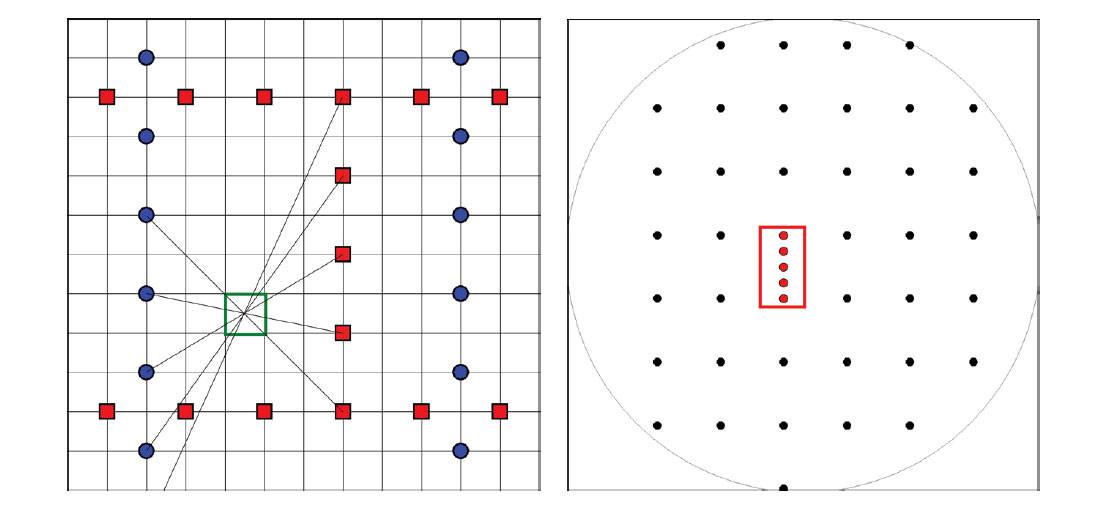
For a given survey there can be several restrictions affecting many bins. In some cases, there may be hundreds of possible source-receiver pairs that satisfy the specified imaging requirements for a given bin. Some of these results may also contribute positively to the trace content in other bins. To objectively choose one set of station locations over another requires a sophisticated ranking scheme for the output. With so many potential station locations, the process of ranking and selecting optimal station locations can only be done algorithmically. If a potential source-receiver pair improves the trace density or statistical diversity within a bin, and also contributes a desired set of offsets or azimuths in a neighboring bin, its effective rank increases. Assessing a group of bins whose trace contents are sub-optimal, determining whether source-receiver pairs exist that can improve the content within each bin, and ranking the resulting locations by effectiveness of contributing traces in the group of bins as a whole leads to the resulting optimal restriction model. The ranked stations can be automatically selected on a contribution basis or on the basis of operational feasibility, and subsequently implemented into the acquisition.
Case Study
The ORM method was used on a recently acquired 3D, which was shot to identify horizontal drilling targets and subtle bypassed pay areas in a relatively shallow Mississippian carbonate field. Target depths were approximately 700-800m. The data is very high frequency with upper limits of 180 Hz and was processed at 1 msec. The pay zones require careful structural understanding to guide horizontal wells; optimization can depend on subtle amplitude changes that indicate facies and porosity changes. In addition, wavelet analysis and inversion have been used to understand production trends.
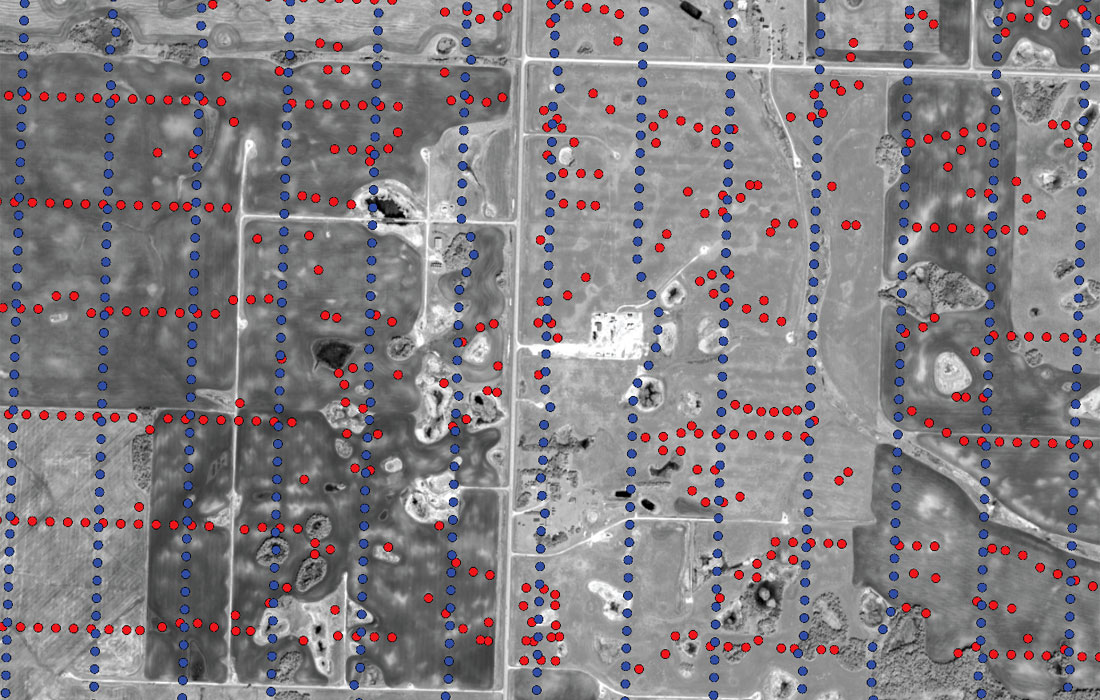
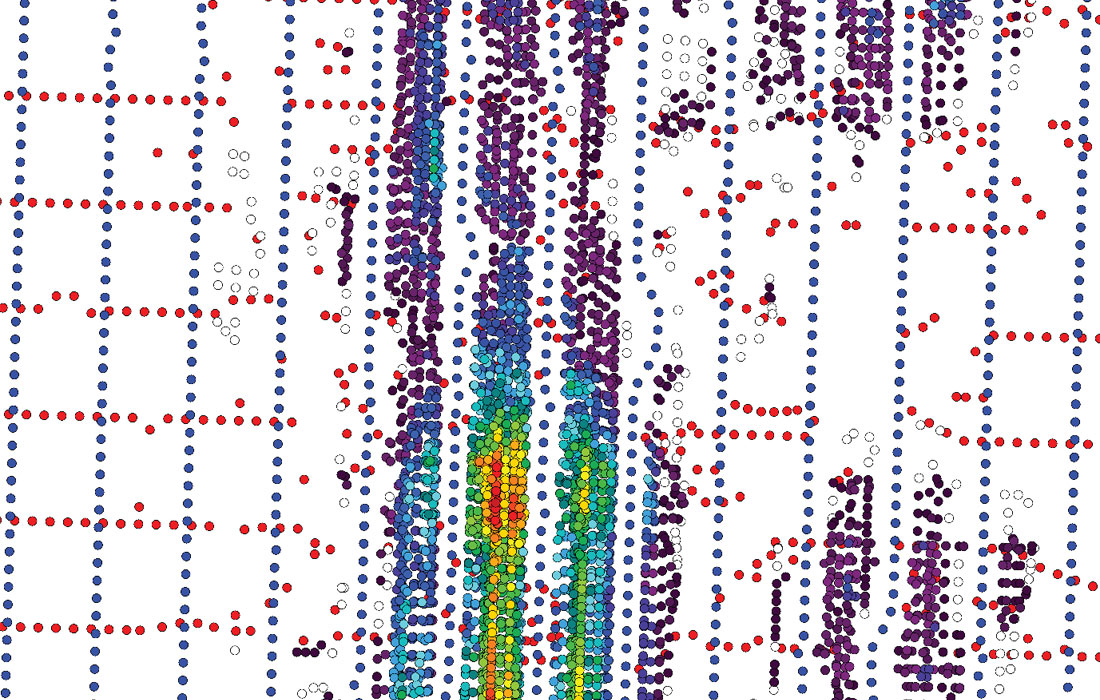

During the surveying stage of the acquisition, source restrictions were identified that negatively affected the trace distribution in several areas. Potential new source locations were determined using the ORM method, with final locations selectively chosen based on imaging effectiveness and operational feasibility. As nodal receivers were used on the program, the decision was made to deploy infill receiver stations to further improve imaging (Millis and Crook, 2012). Due to equipment limitations and the length of the conventional receiver lines within the program, approximately one hundred infill receivers were available to be used within the receiver spread at any given time. This further highlighted the necessity of algorithmically optimizing receiver locations in order to accommodate a dynamic constraint on channel count. Bins that lacked required trace density, offsets, or azimuths were used in the ORM method with locations for the infill receiver stations automatically chosen from the algorithmic result. Figure 7 shows the surveyed source and receiver stations, the ranked result of the ORM method, and those stations chosen to be incorporated into the acquisition. To evaluate the effectiveness of the ORM method on the resulting seismic image, the data was processed with and without the receiver infill stations.
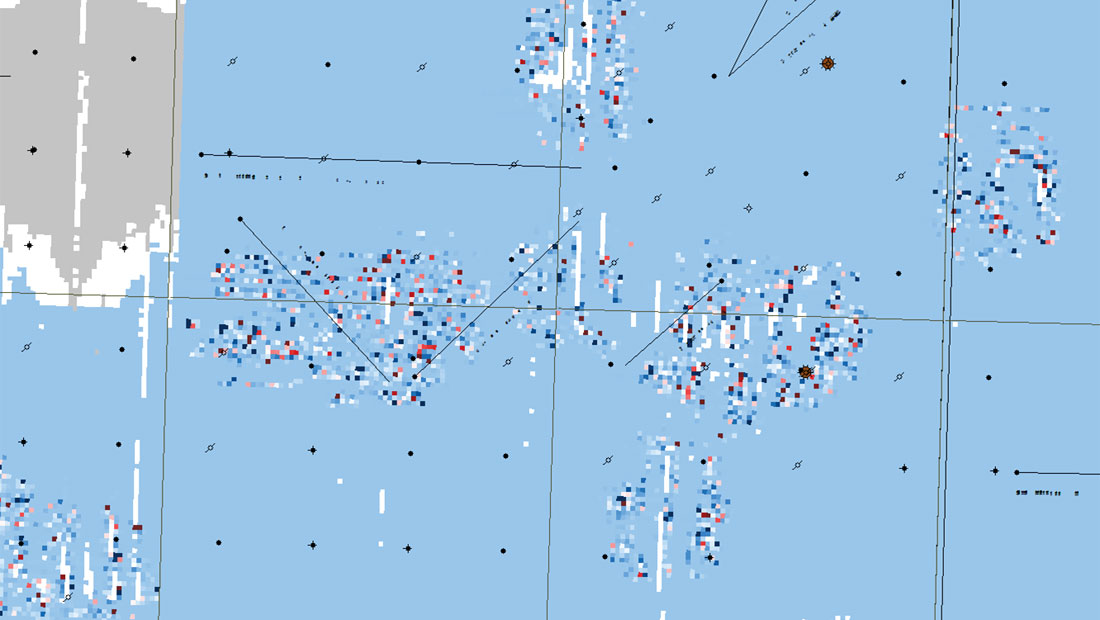
Seismic indicators can be affected by the offset and azimuth inconsistencies that the ORM method seeks to mitigate. Despite the relatively small addition of infill stations, noticeable effects can be detected in Figure 8, which is a ratio of time slice amplitudes in an unmigrated volume near the target level. Light blue colours indicate amplitude ratios where the data with infill receivers is the same as the data without infill receivers. Although most of the area is unaffected, distinct areas, sometimes quite far from the surface alteration, show amplitude effects. These amplitude effects may be vital in detecting porosity and facies changes, which often depend non-linearly on amplitude. Figure 9 illustrates the time differences between horizons on the data with infill receivers versus data without infill receivers. These differences – only approximately 2-5msec – could be extremely important for horizontal drilling, as these time differences could represent as much as 5-10m in the higher velocity carbonates.

Conclusion
To properly account for surface complexities in seismic acquisition, reshaping the surface design process from a station movement framework that is based on “area of responsibility” and does not account for the location of other stations within the survey, to a method that is driven by attribute and imaging objectives has been presented. The ORM method provides station locations that have been optimized algorithmically, and are based on imaging requirements. Improving upon the resulting seismic image, the ORM method has shown to increase confidence in both time structures and amplitudes. Additionally, improving the efficiency of station placement leads to more streamlined operational processes.
The authors would like to thank Corex Resources Ltd., and Crescent Point Energy for permission to use their data. We would also like to thank Sara Dobek and Regan Kennedy at Earth Signal Processing, and Cameron Crook at OptiSeis Solutions Ltd. for their contributions.











Join the Conversation
Interested in starting, or contributing to a conversation about an article or issue of the RECORDER? Join our CSEG LinkedIn Group.
Share This Article